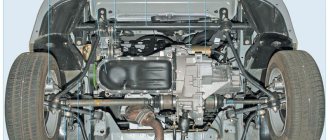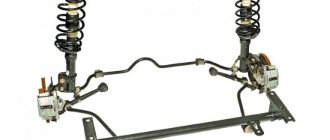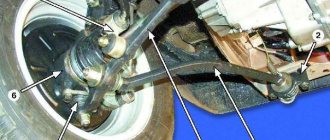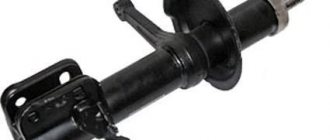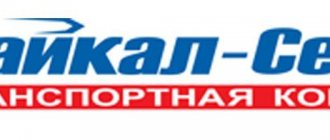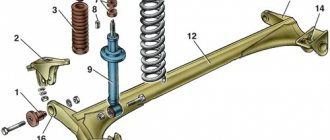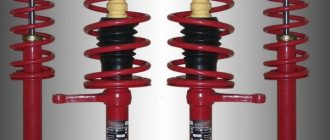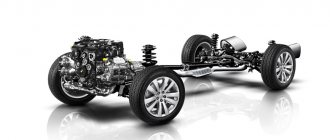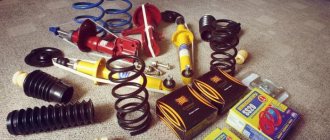The quality and technical features of the suspension are a very important detail for any car, including the Lada Vesta. The stabilization system feature, as well as other innovations in the suspension of the new sedan, became a real sensation for the Russian automobile industry.
In the process of creating the car, the developers had a goal - to create a design that is relevant for Russian roads on a platform that is not inferior in reliability and functionality to the best foreign models. The suspension for the Lada Vesta turned out to be a truly unique creation, created by Russian specialists.
Front suspension
The Lada Vesta is equipped with the most common semi-independent McPherson suspension with a SAAZ shock absorber strut and springs. This chassis has already been tested for years on other car models.
Improvements to AvtoVAZ
Additionally, the manufacturer has developed an L-lever with a split silent block. It replaces the jet rod and lever found on the Grant and previous Lada models. This solution made it possible to give driving comfort and controllability. The lever comes complete with a ball, but it can be replaced separately.
A silent block is placed in the front part of the lever, which provides high lateral rigidity. On the back of the lever is a rubber-to-metal joint that allows the wheel to move slightly rearward. This has a positive effect on the smoothness of the ride.
The steering rack is also attached differently. Now it is connected not to the shock absorber strut, but directly to the steering knuckle.
The suspension still has CV joints of different lengths. A rubber damper is installed on the longer element.
The suspension is mounted on a subframe. This design was new for Lada cars. Now the tolerance for fastening parts has been reduced from 2-3 mm to only 1 mm. This indicates that the suspension elements are assembled more accurately.
Brakes (discs, pads, sensors) Lada Vesta
Products from the Dustershop77 range on the topic of the article:
| Name | Manufacturer | Price | Availability | Add to cart |
| 410607115R | Front brake pads original 440603905R / 410605961R / 410607115R / 410600379R for 280mm disc | Original | 5000 / 4300 rub. Discount: 3900 rub. | 4 |
| 410608481R | Front brake pads Duster, Vesta original 410608481R for disc 260-269mm | Original | 3000 / 2300 rub. Discount: 2200 rub. | 2 |
| DC441-GDB3332 | Front brake pads 1.6 and 2.0, TRW GDB3332 (410608481R for 260-269mm disc) | Analogue | 3000 / 2500 rub. Discount: 2200 rub. | 2 |
| DC1399 | Hex key for replacing pads | Analogue | 200 / 150 rub. Discount: 100 rub. | 4 |
| DC444-23973.175.1 | Front brake pads for disc 260-269mm ZIMMERMANN 23973.175.1 (410608481R) | Analogue | 4000 / 3800 rub. Discount: 3400 rub. | 2 |
| DC1149-8200276361 | Renault brake pedal sensor original 8200276361 | Original | 700 / 550 rub. Discount: 500 rub. | 1 |
| DC510-7701205518 | Set of springs for rear brake pads Duster 4x2 original 7701205518 | Original | 3000 / 2700 rub. Discount: 2500 rub. | 1 |
| DC396-MR0276361 | Brake pedal sensor MANOVER MR0276361 (8200276361) | Analogue | 500 / 400 rub. Discount: 350 rub. | 1 |
| DC627-ASAM32116 | Brake master cylinder with ESP ASAM 32116 (460119952R) | ASAM | 2500 / 2200 rub. Discount: 1800 rub. | 1 |
| DC1657-479703074R | ABS ring Lada Vesta rear original 479703074R | Original | 2000 / 1600 rub. Discount: 1400 rub. | 3 |
| DC1650-8450031577 | Front brake disc Vesta, XRAY original 8450031577 (260mm - 1 pc.) | Original | 2900 / 2500 rub. Discount: 2400 rub. | 2 |
| DC912-QZ-120-0410 | Front pad mounting kit (plates) (D259mm ventilated) Quartz QZ-120-0410 (kit) | Analogue | 1300 / 1000 rub. Discount: 700 rub. | 2 |
| DC1689 | ABS ring Lada Vesta rear analogue 479703074R | Analogue | 1500 / 1000 rub. Discount: 800 rub. | 1 |
| DC2222-410605536R | Front brake pads Vesta, X-Ray, Largus, Sandero, etc. for 258mm disc) original 410605536R, 410604682R, 8660005291 | Original | 2300 / 1600 rub. Discount: 1400 rub. | 1 |
| DC1651-24165 | Front brake discs Lada Vesta, XRAY FEBI (260mm - 2 pcs.) | Analogue | 4900 / 3600 rub. Discount: 3300 rub. | 1 |
| DC1655-11196350208900 | Rear pads Lada Vesta (for disc brakes) original 11196350208900 | Original | 2800 / 2500 rub. Discount: 2200 rub. | 1 |
| DC1652-8450031131 | Rear brake disc Lada Vesta, XRAY original LADA 8450031131 (260mm - 1 piece) | Original | 2700 / 2300 rub. Discount: 2000 rub. | 2 |
| DC1656-440609415R | Rear pads Lada Vesta (for drum brakes) original 440609415R | Original | 2900 / 3200 rub. Discount: 2800 rub. | 1 |
| DC1656-BS-5717 | Rear pads Lada Vesta (for drum brakes) LYNX BS-5717 | Analogue | 1900 / 1500 rub. Discount: 1200 rub. | 1 |
| NF0010851 / 410608481R | Front brake pads NF0010851 Duster, Vesta analogue 410608481R for disc 260-269mm | 750 Discount: 750 rub. | 0 | |
| 000050BSX / 440603905R | Front brake pads Duster (2.0 doors) Stellox 000050BSX non-original, analogue 440603905R for 280mm disc | STELLOX | 1200 Discount: 1200 rub. | 0 |
Advantages of the front suspension:
- More precise control thanks to direct connection of the steering rack to the steering knuckle. Another factor in the good steering response was the rigid silent block.
- Excellent energy efficiency.
- Long lasting resource. Over 90,000 km without replacing components.
- Stabilizer struts last about 40,000 km. For comparison: on other cars they most often last only 10,000 km.
- Large selection of pads: from 200 rub. up to 4,000 rub.
- Structural rigidity of the car, uniform distribution of the load from the suspension on the supporting body, absence of local overloads of the power elements. All this thanks to the subframe.
- Simplified mounting of the suspension and steering rack, also thanks to the use of a subframe.
- Wheel alignment adjustment is based on only one parameter - toe-in. The camber is automatically adjusted to the subframe geometry.
- Good cushioning of impacts on the body when driving on uneven roads.
Stabilizer bushings and struts
To check these elements of the chassis, you can rock the body in the transverse direction together with an assistant, grasping the roof on both sides. If knocking noises appear during such a build-up, this may indicate a malfunction.
Sounds that arise when rocking slightly behind may indicate a loose exhaust system of the car.
By performing these simple steps, you can check the basic elements of the suspension of a modern car. Regular do-it-yourself diagnostics of a car's chassis is available to most car enthusiasts.
This does not require you to have any special skills or abilities. In this case, you do not need to use special tools, a jack, an inspection hole or a lift. The condition of the suspension can be determined almost with bare hands.
According to car repair experts, a large number of cars are operated with faults of varying degrees. Despite the fact that the car rolls heavily in corners and sways after driving over road irregularities, motorists often continue to use it without taking radical measures to eliminate the sources of the problem; drivers adapt to the deterioration in the functioning of the car's chassis. Under such circumstances, serious problems may arise suddenly and cause an emergency.
Front suspension disadvantages:
- Wheel pull to the side due to different lengths of CV joints.
- The FBS sensor is not protected from dirt.
- Exposed part of the shock absorber strut. An unprotected surface will quickly become clogged with dirt.
- Stabilizer bushings creaking. Under heavy loads, the stabilizer bar rotates in the bushings and produces a characteristic sound. The problem occurs on the first Vesta models and is solved by installing a new stabilizer with vulcanized non-removable bushings.
- Play and knocking of stabilizer link hinges on early versions of Vesta.
- Loud suspension operation when overcoming bumps on early versions of Vesta SW Cross.
Price difference
| Manufacturer | Cost, rub.) |
| Xmug | From 2100 |
| VTS | From 1600 |
| Fulcrum | From 2300 |
| Kayaba | From 1300 |
*prices are current as of 10/25/2018
You should not try to find the most inexpensive part - it may turn out to be of poor quality, and you will have to re-purchase a more expensive option. It is better to focus on well-known manufacturers who provide spare parts in the middle price category. Recently, low-quality goods have often been offered at inflated prices.
Station wagon cost:
- Lada Vesta SW from 639,900 to 804,900 rubles.
- Lada Vesta SW Cross from 755,900 to 847,900 rubles.
Having an amount of about 760 thousand rubles, the buyer begins to think about which of the two station wagons is better to buy:
- Lada Vesta SW 1.8L with manual transmission in the Luxe Multimedia package for 761,900 rubles.
- Lada Vesta SW Cross 1.6l with manual transmission in Luxe configuration for 755,900 rubles.
A regular station wagon will have:
- More powerful engine.
- Multimedia system with navigation 7".
- Rear view camera.
A regular station wagon will not have:
- Original body kit.
- Body color "Mars".
- Orange interior trim.
- Exhaust pipe nozzle.
- Increased ground clearance.
- A different suspension (different from the sedan).
- Alloy wheels R17 (will be R16).
Rear suspension
The rear suspension of the Lada Vesta is the pride of AvtoVAZ. The manufacturer claims to have developed it independently. However, it is worth noting that the suspension is actually borrowed from the Renault ZOE electric car.
Its role is played by a semi-independent twisting beam connecting the levers. This design allows you to keep the ground clearance at the same level, even if the car trunk is fully loaded. Twisting beams have long been used on many car models, but AvtoVAZ used this solution for the first time.
Improvements to AvtoVAZ
The shock absorber and spring are separated. This has a positive effect on comfort and smoothness. In addition, to replace the spring you do not have to disassemble the shock absorber. It is worth noting that the Vesta is equipped with a double-action shock absorber, which has a positive effect on the smoothness of the ride.
Previous AvtoVAZ models were equipped with C-shaped rear beams. The U-shaped design is used on the Lada Vesta.
The wishbone acts as a stabilizer bar. If we compare this design with the Renault ZOE suspension, it becomes clear why the Lada manufacturer decided to take the “credit” for the invention of the beam to itself. The length of the wishbone has been increased by 50mm to match the width of the Vesta itself. For this reason, the rear suspension began to be manufactured at AvtoVAZ factories.
Vesta rear suspension shock absorbers are also from a domestic manufacturer. They are made at the SAAZ plant.
Brake system type: drum.
What's new: about built-in technologies and stabilization system
In addition to the Vesta features listed above, it is worth considering a number of other innovations in the chassis, which are no less important. First of all, it is necessary to note the use of systems such as ABS, ESP, and EBD. In addition, the Lada Vesta has power steering from Nissan, and its braking system is equipped with components from Renault Logan and Renault Megane. Acting together, these factors give the car high status and reliability.
The new Lada Vesta has a built-in stabilization and traction control system. The system allows you to easily overcome various skids and drifts of the car while driving.
When the electronics in a car are correctly and professionally configured and are capable of simulating a differential lock, then the vehicle’s cross-country ability significantly improves. The Lada Vesta has just such a system and it is configured really effectively. Now you don’t have to worry about getting into mud, snow, uneven surfaces, or driving off to the side of the road. When the stabilization system is turned on, the Lada goes into all-terrain mode and is able to get out of a difficult situation.
This technology is being used for the first time and, judging by real reviews from car owners, it actually works well and does not fail in difficult conditions.
Suspension diagram
- Levers.
- Bottom gasket on spring.
- Spring.
- Upper gasket on spring.
- Upper support.
- Compression stroke buffer in a protective casing.
- Shock absorber.
- Wheel hub axle.
- Brake drum and wheel bearing.
Trim or install other springs
To cut this at all is some kind of game!
Firstly, there is no 25 cm in a loaded car, which is necessary for comfortable work. Secondly, the work of the suspension will be, on the contrary, torn, and the spring will become a little softer, it simply won’t have enough coils to hold the body normally. The center of gravity of the body will be mixed, which has an extremely negative effect on handling. If you cut off more turns, you will hit the bottom on the road, because again there is not enough spring (let’s say power) to hold the body. YES, the spring can simply fly out of its place.
Install other springs. Hypothetically, this is possible, but they are selected together with shock absorbers (more on this below). But if you make it more powerful, the car will become stiffer, but we need comfort. And if you install it softer than what you had, then the body simply won’t hold up, there will always be breakdowns.
Rear suspension advantages:
- The independent torsion beam design makes the wheel travel more freely. Now it can rotate not only vertically, but also longitudinally. This makes driving more correct. The suspension handles unevenness well, and when cornering the wheel turns to the desired angle.
- To remove the shock absorber strut you only need to unscrew two bolts.
- Uniform distribution of shocks from the road across the body, thanks to the separation of springs and shock absorber struts.
- Easy maintenance due to simplified design.
Differences between the Lada Vesta sedan suspension and SW and SW Cross
In fact, the suspension of the Vesta sedan and station wagon is similar; they have the same wheelbase. But given that the Lada Vesta SV has increased body dimensions, the settings for this part are slightly different.
Also, with a similar design base, the SW Cross has some differences - it has original springs and is equipped with 17″ wheels. Due to this, the ground clearance is increased to 203 mm. In addition, Vesta Cross is equipped with disc brakes and the track width has been increased by 25 mm. That's basically all the differences.
The upper “bar” of front-wheel drive VAZs
In this paragraph, we will briefly consider those technological innovations that were implemented along with the release of the first front-wheel drive cars. Further, it becomes incomprehensible to the Russian consumer why the design solution regarding the design of the car suspension has not changed for decades, as if remaining an insurmountable bar.
Were the ideas too successful? Or VAZ did not risk increasing the cost of a car that was already losing its position. But the fact remains: the suspension design of the VAZ 2108 - VAZ 2170 is practically no different.
To fully appreciate the efforts of AvtoVAZ designers, let’s look at some of the “sores” that the concern faced in 2015. The suspension cannot be called unsuccessful, since the entire line from the “Eight” to the “Priora” will have its fans.
But on the threshold of the 21st century, it was necessary to solve some problems that were turning our cars into Soviet-era cars. While the French or, for example, the Germans made full use of the technology of damper flywheels and pulleys, and also transferred a significant part of the load from the body to the subframe, domestic cars continued to actively respond to the slightest irregularities on the road.
List of reliable online stores
*prices are valid for
Conclusion
The manufacturer has installed an improved suspension, but it has not yet been possible to achieve ideal results. Perhaps, when creating the next new product, all the shortcomings will be corrected, and the suspension will be able to compete with foreign cars.
In general, the car drives smoothly, noise during fast driving has been reduced as much as possible, and the sensitivity of the suspension has decreased.
- https://VestaXray.ru/model/lada-vesta/podveska.html: 4 blocks out of 7 were used, number of characters 3176 (12%)
- https://xn--80aal0a.xn--80asehdb/car-description/photo/lada-vesta-photo/707-osobennosti-podveski-lada-vesta.html: 1 blocks out of 3 used, number of characters 2034 ( 8%)
- https://remont-avtovaz.ru/kak-modernizirovat-podvesky-na-lada-vesta/: 6 blocks out of 9 used, number of characters 6702 (25%)
- https://podveska-avtomobilya.ru/nadezhnost-i-resurs-podveski-lada-vesta-sw-cross.html: 2 blocks out of 6 used, number of characters 4209 (16%)
- https://olade.ru/v-chem-sekret-preimushhestva-novoj-podveski-lada-vesta-pered-starymi: 3 blocks out of 5 were used, number of characters 2843 (11%)
- https://Lada-Vesta-SW.ru/podveska-lada-vesta-cross-obzor-perednej-i-zadnej-video-i-resurs/: 4 blocks out of 9 were used, number of characters 3274 (12%)
- https://xn—-21-43dabppn4d4dn.xn--p1ai/tormoza-i-podveska-lady-vesty/: 5 blocks out of 6 used, number of characters 4568 (17%)
Table
| Parameter | Meaning | ||
| Sedan | Hatchback | Station wagon | |
| Front overhang, mm | 860 | ||
| Rear overhang, mm | 915 | ||
| Approach/departure angle (at full load), degrees. | 16.6/14.2 | ||
| Ground clearance (at full load), under the engine crankcase, mm | 171 | ||
| Minimum ground clearance (clearance), at full load, under the engine mudguard, mm | 144 | ||
| Luggage compartment volume, dm3 | 480 | ||
| Curb weight (without driver), kg | 1178 | ||
| Distribution of curb weight on front/rear axles, % | 60/40 | ||
| Payload, kg | 475 | ||
| Gross (permitted maximum) weight*, kg | 1653 | ||
| Distribution of total weight on front/rear axles, % | 52/48 | ||
| Trailer weight with/without brakes, kg | 900/450 | ||
| Fuel tank capacity, l | 55 | ||
| Tire size | 185/65 R 15 | ||
| 195/55 R 16 | |||
LADA VESTA is created on the new universal platform LADA B, developed by AVTOVAZ independently, where 1,184 out of 1,480 units are completely unique.
Change of platform – change of concept
It all started in the mid-2000s, when the Volga auto giant first risked starting the development of a class C sedan. But then there was not enough money to complete the project, and the crisis of 2008 put a final end to those plans. A few years ago, they returned to the developments that had been collecting dust in the archive, deciding to use them as the basis of a new platform, but for class B cars. At the same time, the task was set to be quite revolutionary - to create a modern platform capable of not being inferior to foreign analogues in terms of quality and technological equipment.
As a result, the LADA B platform was born, which formed the basis of the Lada Vesta sedan. The developers call this project completely unique, because for the first time AvtoVAZ used a whole range of innovations that had not previously been used at all on the products of the Volga auto giant. When creating the platform, the successes of the mid-2000s project were taken into account, but with the introduction of a huge number of amendments and modifications, some technologies used on the Priora were used, as well as technologies from the Renault-Nissan concern, which provided, for example, most of the components of the braking system.
Source
